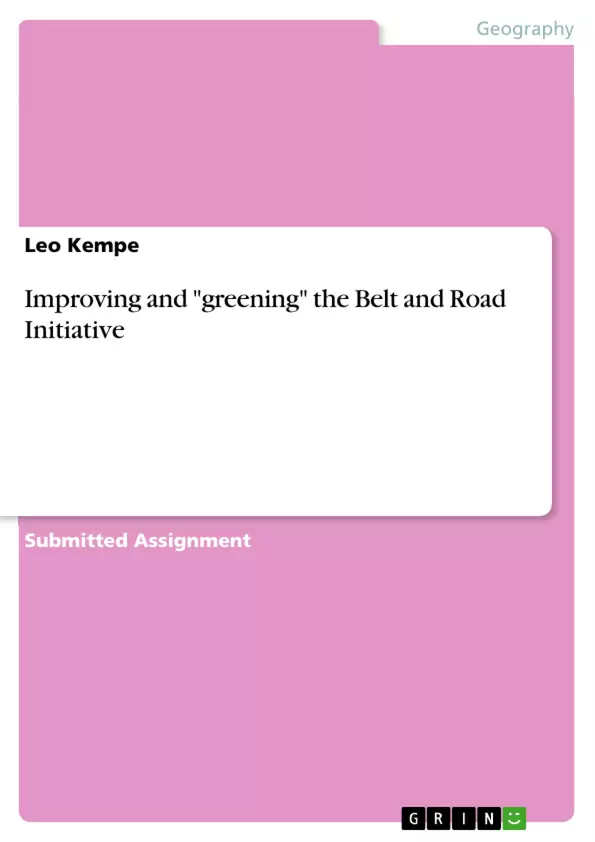This short paper looks at the linkage of the United Nations Sustainable Development Goals and the Belt and Road Initiative (BRI) brought forward by the People's Republic of China in 2015.
It is an endeavor to expand the country's economic reach and to export goods in wider areas of the world. Hence, it can be seen as a tool to achieve a dominating role in the economic realm, which includes gaining ground particularly in raw-material and technological sectors abroad. Because of several critical remarks by the world community, the PRC has pledged to make the BRi a "greener" project, meaning to invest more in sustainable procedures - such as emission reduction.
This, China stresses, should be done to create communities with a shared interest and a common responsibility, automatically evoking thoughts about lowering trade barriers and customs regulations, building strong financial and political institutions, as well as focusing on ecological technologies. Nevertheless, there are still negative effects such as substantial wealth gaps, gender inequalities, and limited economic development capacity along with quite a strong discrepancy between plans and deeds.
Inhaltsverzeichnis (Table of Contents)
- Introduction
- Questions
- "Through what means and processes does a country (here: China) aim to incorporate the three dimensions of sustainability into its global actions?"
- "What causes the shift to a greener approach to development (here: the BRI)?"
- Policy for Sustainable Development
Zielsetzung und Themenschwerpunkte (Objectives and Key Themes)
This paper delves into the benefits and challenges of sustainable development by examining the Green Belt and Road (B&R) Initiative, focusing on China's efforts to incorporate sustainability principles into its global actions. The paper aims to provide a comprehensive overview of the motivations, effects, and lessons learned in greening the BRI.
- The importance of sustainability in development processes, particularly in the context of the BRI
- The role of the PRC's “Going-Out Strategy” in promoting global engagement and economic development
- The challenges and criticisms faced by the BRI due to China's economic dominance and environmental impact
- The PRC's commitment to greening the BRI and the policy frameworks implemented to achieve this goal
- The alignment of the BRI with the UN Sustainable Development Goals (UN SDGs)
Zusammenfassung der Kapitel (Chapter Summaries)
Introduction
The paper introduces the concept of sustainability and its relevance to developmental processes. It highlights the need for a paradigm shift towards greener development practices, particularly in light of environmental concerns and the limitations of the standard economic model. The paper emphasizes the significance of greening the Belt and Road Initiative (BRI) as a means of promoting sustainable development and enhancing China's international reputation.
Questions
This section outlines two key questions that guide the paper's analysis: 1. "Through what means and processes does a country (here: China) aim to incorporate the three dimensions of sustainability into its global actions?" 2. "What causes the shift to a greener approach to development (here: the BRI)?"
The questions emphasize the importance of understanding the motivations, processes, and challenges involved in incorporating sustainability into global initiatives.
Policy for Sustainable Development
This chapter provides an overview of the Belt and Road Initiative (BRI), highlighting its origins, goals, and implementation. It details China's efforts to address concerns regarding the BRI's environmental impact, including the commitment to promoting a greener approach and aligning the initiative with the UN Sustainable Development Goals (UN SDGs).
The chapter explores key policy initiatives, including the Guidance on Promoting Green Belt and Road and the emphasis on "Five Goals" - policy coordination, facilities connectivity, unimpeded trade, financial integration, and people-to-people bonds. The discussion underscores the importance of green financing, Green Global Value Chains (GGVC), and political coordination in achieving sustainability within the BRI context.
Schlüsselwörter (Keywords)
The paper focuses on the key terms and concepts of sustainable development, green development, the Belt and Road Initiative (BRI), the Green Belt and Road (B&R), the United Nations Sustainable Development Goals (UN SDGs), green financing, Green Global Value Chains (GGVC), and the role of the PRC in promoting sustainable development on a global scale.
- Arbeit zitieren
- Leo Kempe (Autor:in), 2022, Improving and "greening" the Belt and Road Initiative, München, GRIN Verlag, https://www.grin.com/document/1441564



